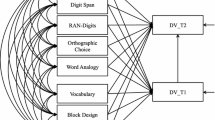Abstract
Japanese kanji reading can be divided into two types: On-readings, derived from the original Chinese pronunciation and Kun-readings, originating from the Japanese pronunciation. Kanji that are normally given an On-reading around 50% of the time were presented in a context of other kanji that had either a highly dominant On-reading or a highly dominant Kun-reading. The reading that was given in this experiment was very much biased toward the type of phonological environment in which it was embedded. So native Japanese speakers easily shifted between On and Kun readings, depending on phonological context, suggesting that separate On and Kun sub-lexica exist within the phonological lexicon.
Similar content being viewed by others
Notes
The pronunciation of Japanese words in this paper is transcribed using Japanese phonemic symbols which indicate three special sounds in Japanese: /N/ for nasal, /Q/ for geminate and /R/ for long vowel.
The single-kanji word /kiku/ is On-reading and is classified as Kango. This word, however, represents sequential voicing, or rendaku as in /no + giku/ (voiceless /k/ changes to voiced /g/) ‘a wild chrysanthemum’ which is usually a phonological feature of Wago. This is one of examples of vulgarized Sino-Japanese or zokukango.
References
Fukazawa, H., & Kitahara, M. (2004). Nihongo no goisoo to tangorashisa no kankei ni tsuite [Wordlikeness for lexical strata in Japanese]. Speech and Grammar, 4, 145–160.
Hirose, H. (1998). Identifying the On- and Kun-readings of Chinese characters: Identification of On versus Kun as a strategy-based judgment. In C. K. Leong & K. Tamaoka (Eds.), Cognitive processing of the Chinese and the Japanese languages (pp. 375–394). Dordrecht, The Netherlands: Kluwer Academic Publishers.
Ito, J., & Mester, A. (1995). Japanese phonology. In J. Goldsmith (Ed.), The handbook of phonological theory (pp. 817–838). Cambridge, MA: Backwell.
Ito, J., & Mester, A. (2003). Japanese morphophonemics: Markedness and word structure (Linguistics inquiry monograph forty-one). Cambridge, MA: MIT Press.
Kaiho, H., & Nomura, Y. (1983). Kanji joho shori no shinrigaku [The psychology of kanji information processing]. Tokyo: Kyoiku Shuppan.
Kawakami, M. (1997). JIS 1-shu kanji 2,965-ji o mochiite sakusei sareru kanji niji jyukugosuu hyoo [Tables of two-kanji compound words constructed with 2,965 JIS 1-st kanji characters]. School of Education Bulletin (Nagoya University), 44, 243–299.
Kess, J. F., & Miyamoto, T. (1999). The Japanese mental lexicon: Psycholinguistic studies of kana and kanji processing. Philadelphia: John Benjamins Publishing Company.
Leong, C. K., Cheng, P.-W., & Mulcahy, R. (1987). Automatic processing of morphemic orthography. Language and Speech, 30, 181–196.
Leong, C. K., & Tamaoka, K. (1995). Use of phonological information in processing kanji and katakana by skilled and less skilled Japanese readers. Reading and Writing: An Interdisciplinary Journal, 7, 377–393.
Nomura, Y. (1978). Kanji no joho shori: On-doku kun-doku no imi no fuka [The information processing of Chinese characters (kanji): Chinese reading, Japanese reading and the attachment of meaning]. Japanese Journal of Psychology, 49, 190–197.
Nomura, Y. (1979). Kanji no joho shori: On-doku kun-doku no kensaku katei [Information processing of Chinese characters (Kanji): Retrieval processes in Chinese-style reading (On) and Japanese-style reading (Kun)]. Japanese Journal of Psychology, 50, 101–105.
Nomura, M. (1989). Kanji no zoogo ryoku [Productivity of kanji]. In K. Sato (Ed.), Kanji kooza Vol. 1—Kanji towa [Kanji lecture series Vol. 1—What is kanji?] (pp. 193–217). Tokyo: Meiji Shoin.
Taft, M., Huang, J., & Zhu, X. P. (1994). The influence of character frequency on word recognition responses in Chinese. In H.-W. Chang, J.-T. Huang, C.-W. Hue, & O. J. L. Tzeng (Eds.), Advances in the study of Chinese language processing (Vol. 1, pp. 59–73). Taipei, Taiwan: Department of Psychology, National Taiwan University.
Taft, M., & Zhu, X. P. (1995). The representation of bound morphemes in the lexicon: A Chinese study. In L. B. Feldman (Ed.), Morphological aspects of language processing (pp. 293–316). Hillsdale, NJ: Lawrence Erlbaum Associates.
Takayama, T. (1999). Shakuyoogo no rendaku/koo’onka ni tsuite [Sequential voicing and fortis in loan vocabulary]. Report of the special research project for the typological investigation of languages and cultures of the East and West #1 (pp. 375–385). Tsukuba: Tsukuba University.
Tamaoka, K. (2003). Where do statistically-derived indicators and human strategies meet when identifying On- and Kun-readings of Japanese kanji? Cognitive Studies, 10, 441–468.
Tamaoka, K., & Hatsuzuka, M. (1995). Kanji niji jukugo no shori ni okeru kanji shiyoo hindo no eikyoo [The effects of Kanji printed-frequency on processing Japanese two-morpheme compound words]. The Science of Reading, 39, 121–137.
Tamaoka, K., Kirsner, K., Yanase, Y., Miyaoka, Y., & Kawakami, M. (2002). A web-accessible database of characteristics of the 1,945 Japanese basic kanji. Behavior Research Methods, Instruments and Computers, 34, 260–275.
Tamaoka, K., & Makioka, S. (2004). New figures for a Web-accessible database of the 1,945 basic Japanese kanji, fourth edition. Behavior Research Methods, Instruments and Computers, 36, 548–558.
Vance, T. J. (1987). An introduction to Japanese phonology. Albany, NY: State University of New York Press.
Wu, J. -T., Chou, T. -L., & Liu, I. -M. (1994). The locus of the character/word frequency effect. In H.-W. Chang, J.-T. Huang, C.-W. Hue, & O. J. L. Tzeng (Eds.), Advances in the study of Chinese language processing (Vol. 1, pp. 31–58). Taipei, Taiwan: Department of Psychology, National Taiwan University.
Yokoyama, S., Sasahara, H., Nozaki, H., & Long, E. (1998). Shinbun denshi media no kanji–Asahi shinbun CD-ROM niyoru kanji hindo hyoo [Japanese kanji in the newspaper media–Kanji frequency index from the Asahi newspaper on CD-ROM]. Tokyo: Sanseido.
Zhang, B., & Peng, D. (1992). Decomposed storage in the Chinese lexicon. In H.-C. Chen & O. J. L. Tzeng (Eds.), Language processing in Chinese (pp. 131–149). Amsterdam: North-Holland.
Zhou, X., & Marslen-Wilson, W. (1994). Words, morphemes and syllables in the Chinese mental lexicon. Language and Cognitive Processes, 9, 393–422.
Author information
Authors and Affiliations
Corresponding author
Rights and permissions
About this article
Cite this article
Tamaoka, K., Taft, M. The sensitivity of native Japanese speakers to On and Kun kanji readings. Read Writ 23, 957–968 (2010). https://doi.org/10.1007/s11145-009-9184-8
Received:
Accepted:
Published:
Issue Date:
DOI: https://doi.org/10.1007/s11145-009-9184-8



